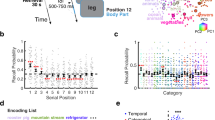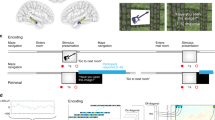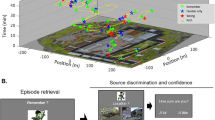Abstract
In the endeavor to understand how our brains enable our multifaceted memories, much controversy surrounds the contributions of the hippocampus and perirhinal cortex (PrC). We recorded functional magnetic resonance imaging (fMRI) in healthy controls and intracranial electroencephalography (EEG) in patients during a recognition memory task. Although conventional fMRI analysis showed indistinguishable roles of the hippocampus and PrC in familiarity-based item recognition and recollection-based source retrieval, event-related fMRI and EEG time courses revealed a clear temporal dissociation of memory signals in and across these regions. An early source retrieval effect was followed by a late, post-decision item novelty effect in hippocampus, whereas an early item novelty effect was followed by a sustained source retrieval effect in PrC. Although factors such as memory strength were not experimentally controlled, the temporal pattern across regions suggests that a rapid item recognition signal in PrC triggers a source retrieval process in the hippocampus, which in turn recruits PrC representations and/or mechanisms, evidenced here by increased hippocampal-PrC coupling during source recognition.
This is a preview of subscription content, access via your institution
Access options
Subscribe to this journal
Receive 12 print issues and online access
$209.00 per year
only $17.42 per issue
Buy this article
- Purchase on Springer Link
- Instant access to full article PDF
Prices may be subject to local taxes which are calculated during checkout





Similar content being viewed by others
References
Scoville, W.B. & Milner, B. Loss of recent memory after bilateral hippocampal lesions. J. Neurol. Neurosurg. Psychiatry 20, 11–21 (1957).
Squire, L.R., Stark, C.E. & Clark, R.E. The medial temporal lobe. Annu. Rev. Neurosci. 27, 279–306 (2004).
Davachi, L. Item, context and relational episodic encoding in humans. Curr. Opin. Neurobiol. 16, 693–700 (2006).
Mayes, A., Montaldi, D. & Migo, E. Associative memory and the medial temporal lobes. Trends Cogn. Sci. 11, 126–135 (2007).
Johnson, M.K., Hashtroudi, S. & Lindsay, D.S. Source monitoring. Psychol. Bull. 114, 3–28 (1993).
Cohen, N.J. & Eichenbaum, H.E. Memory, Amnesia and the Hippocampal System (MIT Press, Cambridge, Massachusetts, 1993).
Diana, R.A., Yonelinas, A.P. & Ranganath, C. Imaging recollection and familiarity in the medial temporal lobe: a three-component model. Trends Cogn. Sci. 11, 379–386 (2007).
Eichenbaum, H., Yonelinas, A.P. & Ranganath, C. The medial temporal lobe and recognition memory. Annu. Rev. Neurosci. 30, 123–152 (2007).
Manns, J.R., Hopkins, R.O., Reed, J.M., Kitchener, E.G. & Squire, L.R. Recognition memory and the human hippocampus. Neuron 37, 171–180 (2003).
Stark, C.E., Bayley, P.J. & Squire, L.R. Recognition memory for single items and for associations is similarly impaired following damage to the hippocampal region. Learning Mem. 9, 238–242 (2002).
Squire, L.R., Wixted, J.T. & Clark, R.E. Recognition memory and the medial temporal lobe: a new perspective. Nat. Rev. Neurosci. 8, 872–883 (2007).
Wais, P.E., Squire, L.R. & Wixted, J.T. In search of recollection and familiarity signals in the hippocampus. J. Cogn. Neurosci. 22, 109–123 (2010).
Jacoby, L.L. A process dissociation framework: separating automatic from intentional uses of memory. J. Mem. Lang. 30, 513–541 (1991).
Mandler, G. Recognizing: the judgment of previous occurrence. Psychol. Rev. 87, 252–271 (1980).
Yonelinas, A.P. The nature of recollection and familiarity: a review of 30 years of research. J. Mem. Lang. 46, 441–517 (2002).
McElree, B., Dolan, P.O. & Jacoby, L.L. Isolating the contributions of familiarity and source information to item recognition: A time course analysis. J. Exp. Psychol. Learn. Mem. Cogn. 25, 563–582 (1999).
Curran, T. Brain potentials of recollection and familiarity. Mem. Cognit. 28, 923–938 (2000).
Aggleton, J.P. & Brown, M.W. Episodic memory, amnesia and the hippocampal-anterior thalamic axis. Behav. Brain Sci. 22, 425–444 (1999).
Duarte, A., Henson, R.N. & Graham, K.S. Stimulus content and the neural correlates of source memory. Brain Res. 1373, 110–123 (2011).
Staresina, B.P. & Davachi, L. Object unitization and associative memory formation are supported by distinct brain regions. J. Neurosci. 30, 9890–9897 (2010).
Diana, R.A., Yonelinas, A.P. & Ranganath, C. The effects of unitization on familiarity-based source memory: testing a behavioral prediction derived from neuroimaging data. J. Exp. Psychol. Learn. Mem. Cogn. 34, 730–740 (2008).
Henson, R.N., Shallice, T., Josephs, O. & Dolan, R.J. Functional magnetic resonance imaging of proactive interference during spoken cued recall. Neuroimage 17, 543–558 (2002).
Maris, E. & Oostenveld, R. Nonparametric statistical testing of EEG and MEG data. J. Neurosci. Methods 164, 177–190 (2007).
Fell, J. et al. Human memory formation is accompanied by rhinal-hippocampal coupling and decoupling. Nat. Neurosci. 4, 1259–1264 (2001).
Jutras, M.J., Fries, P. & Buffalo, E.A. Gamma-band synchronization in the macaque hippocampus and memory formation. J. Neurosci. 29, 12521–12531 (2009).
Haegens, S., Nácher, V., Luna, R., Romo, R. & Jensen, O. α-Oscillations in the monkey sensorimotor network influence discrimination performance by rhythmical inhibition of neuronal spiking. Proc. Natl. Acad. Sci. USA 108, 19377–19382 (2011).
Kirwan, C.B. & Stark, C.E. Medial temporal lobe activation during encoding and retrieval of novel face-name pairs. Hippocampus 14, 919–930 (2004).
Xiang, J.Z. & Brown, M.W. Differential neuronal encoding of novelty, familiarity and recency in regions of the anterior temporal lobe. Neuropharmacology 37, 657–676 (1998).
Buckner, R.L., Wheeler, M.E. & Sheridan, M.A. Encoding processes during retrieval tasks. J. Cogn. Neurosci. 13, 406–415 (2001).
Stark, C.E. & Okado, Y. Making memories without trying: medial temporal lobe activity associated with incidental memory formation during recognition. J. Neurosci. 23, 6748–6753 (2003).
Konkel, A. & Cohen, N.J. Relational memory and the hippocampus: representations and methods. Frontiers in Neuroscience 3, 166–174 (2009).
Ludowig, E. et al. Intracranially recorded memory-related potentials reveal higher posterior than anterior hippocampal involvement in verbal encoding and retrieval. J. Cogn. Neurosci. 20, 841–851 (2008).
Rutishauser, U., Schuman, E.M. & Mamelak, A.N. Activity of human hippocampal and amygdala neurons during retrieval of declarative memories. Proc. Natl. Acad. Sci. USA 105, 329–334 (2008).
Viskontas, I.V., Knowlton, B.J., Steinmetz, P.N. & Fried, I. Differences in mnemonic processing by neurons in the human hippocampus and parahippocampal regions. J. Cogn. Neurosci. 18, 1654–1662 (2006).
Axmacher, N. et al. Intracranial EEG correlates of expectancy and memory formation in the human hippocampus and nucleus accumbens. Neuron 65, 541–549 (2010).
Köhler, S., Danckert, S., Gati, J.S. & Menon, R.S. Novelty responses to relational and non relational information in the hippocampus and the parahippocampal region: A comparison based on event related fMRI. Hippocampus 15, 763–774 (2005).
Kumaran, D. & Maguire, E.A. Novelty signals: a window into hippocampal information processing. Trends Cogn. Sci. 13, 47–54 (2009).
Grunwald, T. et al. Dissecting out conscious and unconscious memory (sub)processes within the human medial temporal lobe. Neuroimage 20 (suppl. 1), S139–S145 (2003).
Meunier, M., Bachevalier, J., Mishkin, M. & Murray, E.A. Effects on visual recognition of combined and separate ablations of the entorhinal and PrC in rhesus monkeys. J. Neurosci. 13, 5418–5432 (1993).
Murray, E.A. & Richmond, B.J. Role of PrC in object perception, memory, and associations. Curr. Opin. Neurobiol. 11, 188–193 (2001).
Gonsalves, B.D., Kahn, I., Curran, T., Norman, K.A. & Wagner, A.D. Memory strength and repetition suppression: multimodal imaging of medial temporal cortical contributions to recognition. Neuron 47, 751–761 (2005).
Henson, R.N., Cansino, S., Herron, J., Robb, W. & Rugg, M. A familiarity signal in human anterior medial temporal cortex? Hippocampus 13, 301–304 (2003).
Montaldi, D., Spencer, T.J., Roberts, N. & Mayes, A.R. The neural system that mediates familiarity memory. Hippocampus 16, 504–520 (2006).
Grunwald, T., Lehnertz, K., Heinze, H.J., Helmstaedter, C. & Elger, C.E. Verbal novelty detection within the human hippocampus proper. Proc. Natl. Acad. Sci. USA 95, 3193–3197 (1998).
Buckley, M.J. & Gaffan, D. Perirhinal cortex ablation impairs configural learning and paired-associate learning equally. Neuropsychologia 36, 535–546 (1998).
Higuchi, S. & Miyashita, Y. Formation of mnemonic neuronal responses to visual paired associates in inferotemporal cortex is impaired by perirhinal and entorhinal lesions. Proc. Natl. Acad. Sci. USA 93, 739–743 (1996).
Staresina, B.P. & Davachi, L. Differential encoding mechanisms for subsequent associative recognition and free recall. J. Neurosci. 26, 9162–9172 (2006).
Diana, R.A., Yonelinas, A.P. & Ranganath, C. Medial temporal lobe activity during source retrieval reflects information type, not memory strength. J. Cogn. Neurosci. 22, 1808–1818 (2010).
Takeuchi, D., Hirabayashi, T., Tamura, K. & Miyashita, Y. Reversal of interlaminar signal between sensory and memory processing in monkey temporal cortex. Science 331, 1443–1447 (2011).
Gelbard-Sagiv, H., Mukamel, R., Harel, M., Malach, R. & Fried, I. Internally generated reactivation of single neurons in human hippocampus during free recall. Science 322, 96–101 (2008).
Brainard, D.H. The Psychophysics Toolbox. Spat. Vis. 10, 433–436 (1997).
Stark, C.E. & Squire, L.R. When zero is not zero: the problem of ambiguous baseline conditions in fMRI. Proc. Natl. Acad. Sci. USA 98, 12760–12766 (2001).
Dale, A.M. Optimal experimental design for event-related fMRI. Hum. Brain Mapp. 8, 109–114 (1999).
Insausti, R. et al. MR volumetric analysis of the human entorhinal, perirhinal, and temporopolar cortices. AJNR Am. J. Neuroradiol. 19, 659–671 (1998).
Brett, M., Anton, J.-L., Valabregue, R. & Poline, J.-B. Region of interest analysis using an SPM toolbox [abstract]. in 8th Int. Conf. on Functional Mapping of the Human Brain (eds. R. Kawashima, H. Sakata, K. Nakamura & M. Taira) (Academic Press, 2002).
McCarthy, G., Nobre, A.C., Bentin, S. & Spencer, D.D. Language-related field potentials in the anterior-medial temporal lobe. I. Intracranial distribution and neural generators. J. Neurosci. 15, 1080–1089 (1995).
Smith, M.E., Stapleton, J.M. & Halgren, E. Human medial temporal lobe potentials evoked in memory and language tasks. Electroencephalogr. Clin. Neurophysiol. 63, 145–159 (1986).
Oostenveld, R., Fries, P., Maris, E. & Schoffelen, J.M. FieldTrip: open source software for advanced analysis of MEG, EEG, and invasive electrophysiological data. Comput. Intell. Neurosci. 2011, 156869 (2011).
Jokisch, D. & Jensen, O. Modulation of gamma and alpha activity during a working memory task engaging the dorsal or ventral stream. J. Neurosci. 27, 3244–3251 (2007).
Meeuwissen, E.B., Takashima, A., Fernández, G. & Jensen, O. Increase in posterior alpha activity during rehearsal predicts successful long-term memory formation of word sequences. Hum. Brain Mapp. 32, 2045–2053 (2011).
Acknowledgements
We thank A. Greve for helpful discussion. This work was supported by a Sir Henry Wellcome Postdoctoral Fellowship to B.P.S., the UK Medical Research Council Program (MC_A060_5PR10 to R.N.H.) and the German Research Foundation (DFG FE 366/5-1 to A.T.A.D.L.)
Author information
Authors and Affiliations
Contributions
B.P.S. and R.N.H. designed the research. B.P.S., N.A., J.F. and R.N.H. wrote the manuscript. B.P.S. conducted the experiments and analyzed the data. A.T.A.D.L. assisted in conducting the iEEG experiments.
Corresponding author
Ethics declarations
Competing interests
The authors declare no competing financial interests.
Supplementary information
Supplementary Text and Figures
Supplementary Figures 1 and 2, Supplementary Tables 1 and 2, and Supplementary Results (PDF 842 kb)
Rights and permissions
About this article
Cite this article
Staresina, B., Fell, J., Do Lam, A. et al. Memory signals are temporally dissociated in and across human hippocampus and perirhinal cortex. Nat Neurosci 15, 1167–1173 (2012). https://doi.org/10.1038/nn.3154
Received:
Accepted:
Published:
Issue Date:
DOI: https://doi.org/10.1038/nn.3154
This article is cited by
-
The Speed of Hippocampal Processing of Contextual Information is Linked with Its Congruence with Previously Developed Schemas
Neuroscience and Behavioral Physiology (2023)
-
Recollection in the human hippocampal-entorhinal cell circuitry
Nature Communications (2019)
-
Dynamic laminar rerouting of inter-areal mnemonic signal by cognitive operations in primate temporal cortex
Nature Communications (2018)
-
Sleep selectively stabilizes contextual aspects of negative memories
Scientific Reports (2018)
-
Role of the Hippocampus in Distinct Memory Traces: Timing of Match and Mismatch Enhancement Revealed by Intracranial Recording
Neuroscience Bulletin (2017)



